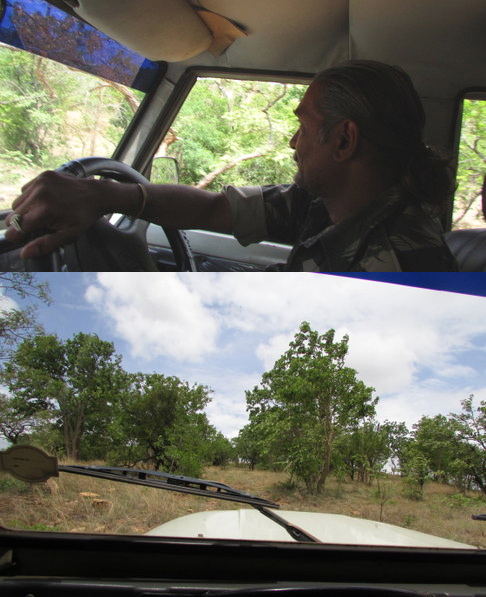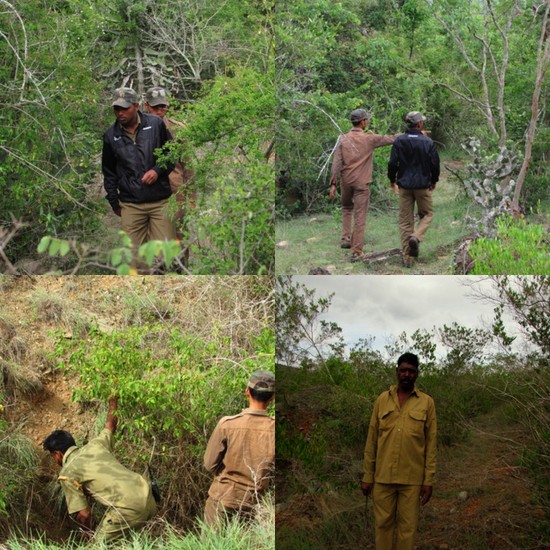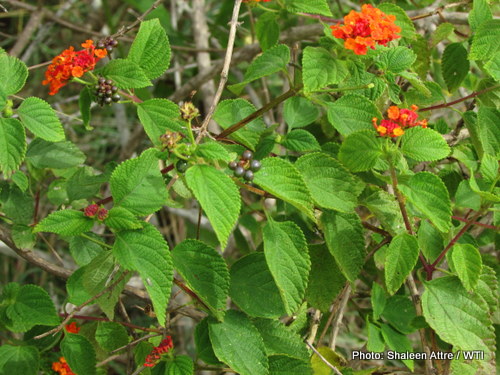Shaleen Attre
Project Officer, Awareness for Conservation
As the jeep rumbled past the small houses, the villagers of Chikkaelachetti barely paused from their chores to look at the vehicle full of uniformed guards of the Special Tiger Protection Force (STPF) and three civilians in green- Nagraj Bhatt (Field Officer), Jose Louies (Regional Head- South India and Head- Enforcement) and me- on the way to the jungle. A known sight in the area, Nagraj Bhatt, WTI’s Field Officer, and his jeep were well recognised in Bandipur Tiger Reserve. A few guards walking by raised their hands in acknowledgement as Bhatt reciprocated the gesture, maintaining a firm grip on the wheel as the jeep now stumbled off the semi-paved roads onto the uneven path leading to the jungle.

Expertly maneuvering his way around the shrubs and trees, Bhatt finally stopped the jeep at a point in the Kundekere Range and said, “This is where you get off and walk. Let me once again explain the Hejje equipment to two of these watchers who will be using it for the first time and you’re good to go.”
Hejje, meaning footsteps in Kannada, is an ingenious software which with its simple User Interface (UI) has brought together technology and tracking together on a platform easy for the guards to understand and use. With literally a start and stop button upon opening this android based software, it helps the guards collect information on the area they’re walking in. The guards can even take photos from the field with space for both direct and indirect sightings incorporated within the system. About 10 units were given last week to the STPF staff in a WTI Rapid Action Project, supported by Aircel.

After a quick training session, Bhatt fished out a map from the back seat and laid it on the jeep’s hood. “You’re here right now. This is one point 5 km from here and there’s the second point 10 km away. You see that white speck on that mountain? That’s where I’ll meet you with the jeep,” said Bhatt pointing to a hill in the distance.
Stopping every now and then to look for snares, Dore Naika, one of the forest watchers who could converse in Hindi, said that we’ll probably never actually find a snare in this walk. “When the patrolling was started some years ago with WTI’s assistance, several hundred snares were found and in this beat alone we must have found some 200 snares. But now it’s been several months and we’ve not found a single snare in the forest,” said Naika proudly.
“So is it just the patrolling and fear of being caught that has stopped the villagers from putting the snares?” I asked curiously, trying to gauge the sustainability of such an initiative.
“Take any village around here. We’ve done extensive awareness work with them and now in fact a number of them help inform us when they get the whiff of any illegal activity around here. We’re not saying no one here eats bush meat anymore or don’t poach, but the incidents are negligible compared to what they used to be earlier. A sense of pride for their forest and wildlife heritage has been inculcated in the locals. The village youth are also saying that they want to come and join the department and help protect the forests,” Dore remarked with exultation.
“There used to be 11 tigers here in 1973 in Bandipur. Now the landscape, spread over 1020 sq km, has the second highest number of tigers in the country standing at a number of 180!” he added with all the excitement of a father showing off.
As we walked deeper into the jungle, all one could hear at one point were the ‘seven sisters’ babbling away. A loud crack of a broken twig suddenly burst into their babble and we whipped around to see a sambar galloping away at full speed, anxious to put as much space as possible between us and him (or her?).

Not exactly used to walking in the jungle every day myself, I was quite bemused seeing the STPF staff cantering on the hills like goats, nimbly jumping over any loose stones and deftly avoiding all thickets and thorns. About 2 km inside the jungle, we decided to stop near a stream for 10 minutes. Even though monsoons had started in Karnataka and it had been raining heavily for days, that day the sun-God seemed to be smiling on us a little too brightly. As everyone climbed on top of the rocks to get the best seats in the house, I noticed Dore was wearing regular flip-flops and asked him where his shoes were. “Oh they’re at home. I was in a hurry and just put these on. I’m used to walking in these anyway. Shoes had been given relatively recently to us in fact by WTI,” he said.
He turned around and looked at Bomme Gowda, another watcher sitting right behind me. “It’s still okay for me you know. I’m at a relatively okay position and can at least afford a pair of shoes and slippers on my own once in a while. But a watcher like Bomme Gowda who’s been walking in this forest for years still gets paid the basic minimum wage. His salary cannot be more than 5000-6000 a month. How can he afford things like raincoats and proper walking shoes when he has a family to feed and an ailing mother sitting in his village home?” Dore asked me.
As I looked at Bomme Gowda, he just gave me a shy smile and looked at ripples in the water below, created by a tadpole. “How far have all of you studied?” I asked.
“I’ve done my B.Ed. Puneeth has even done his BCom! Bomme however never went to school. The others have passed high school at least,” Dore replied.
“So does support given by us, like the raincoats and Hejje sponsored by Aircel, help you all a lot?” I asked despite knowing the answer. Dore retorted immediately, “Of course it does! Like I said, our salaries aren’t too high, the Forest Department does all it can for us but even they have their limitations. We need as much help as we can. With the monsoons coming up for instance, a number of us were wondering how we’re even going to carry out patrolling since most of our salaries have gone home. But now at least we know we won’t be catching a cold everyday and falling sick!”
“So do you go for patrolling everyday or is it a weekly activity?” wondering how much I had tested Dore’s patience as I asked my umpteenth question. “10-15 km is our usual beat. Take this route we’re taking, of the Chigrekadu beat for instance. Now this is a known habitat for at least 5-6 tigers and we have to make sure that even though not a single snare has been found in almost a year, even one accidentally left behind by us could mean one tiger less in the forest,” he said.
I enquired if he had ever come across any tiger while on his beat. “No ma’am,” he said with his ever-lasting smile. “It’s almost as if the wildlife of this forest knows that we’re not here to harm them. They probably do see us from the distance since we have found fresh pugmarks on occasion, but as long we leave them alone and don’t disturb them, they don’t disturb us. We’re very wary of the elephants though! Constantly have to keep our noses tuned to their smell. Now that’s one unpredictable animal! You won’t even know that they’re right behind until it’s too late for you.”
As we make way to our final point some kilometers away, I am exhilarated (and partly exhausted not used to walking uphill in a jungle everyday!) at being away from the city, fascinated that my phone gets 3G coverage inside the jungle but not in the resorts in the outskirts and simply wondering how long it would be before I get to do such a walk again.

As we passed the last 300 m of the walk, I glanced at the multiple bushes of lantana abounding the region. An invasive species in the forest, brought to this land by the British for ornamental purposes, lantana has grown to be quite an imposing growth in the region not suitable for most herbivores. Photo: Shaleen Attre / WTI

Spotted deer foraging amongst burnt lantana in Bandipur National Park. Photo: Shaleen Attre / WTI
We found Nagraj Bhatt waiting for us at the end-point with bottles of water (special from a pond he claimed with a twinkle in his eye) and several packets of Parle-G. Jose thrusted a few biscuits in my hand extremely amused at my face having turned red after the walk under the sun as Nagraj distributed this ‘lifeline’ to everyone. All fed and watered, we clambered back into the jeep and made a quick pit-stop at the STPF’s anti-poaching camp a few kilometers away.
Loaded with only bare minimum necessities, my attention was caught immediately by a strong-hold looking iron chest in the corner of the room. “Surely, you don’t get thieves in the middle of the jungle?” I asked. “That’s for our resident bears! We have one who loves to come and raid our supplies frequently and this was the only solution we could come up with,” Dore said, while handing me a plastic mug of ‘special drinking water’ as they liked to call the local hand-pump produce.
Nagraj Bhatt pointed to the far end of the room and commented on them using firewood chulhas, “It’s not good for them. They really need smokeless chulhas in here otherwise they will seriously start falling sick in these closed quarters.”
Promising to look into this, Jose and I followed Nagraj Bhatt, Naveen and Puneeth out to the vehicle. “We hope that we could help you in whatever way we could Ma’am,” Dore said with all the grace of a good host. I thanked him and the others profusely for humouring me and patiently answering my queries and of course waiting for me when I was too tired to climb up a hill after one point!
As I waved them goodbye, I couldn’t help but marvel at the resilience of this lot who could have entered any mainstream industry, chosen any career they wanted to but their valiance and loyalty to wildlife and nature kept them where they were, insisting and demanding to be the guardians of the wild.